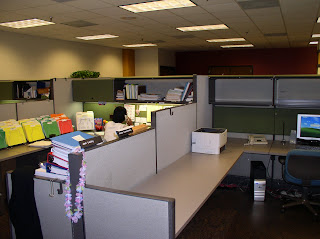Another Work From Home (WFH) Update

In this picture Kristie Cantrell is sitting next to her empty cubicle in the space she now shares with Jack Leichty. The two started today working on alternating days in the office and working from home the rest of the work week. The big move was Friday but has been in the works for weeks. Note that both their name plates are now affixed on the same cubicle wall. To make sure that two people could work from the same space, we required that Kristie's former space be completely emptied, wiped down, and that it not be used for storage. Both of them now have 100% of the materials they need for their immediate work area in one cubicle, or at their home offices.
This was no small feat. Since neither uses a laptop IT moved both of them from their desktop PCs to a virtual desktop on the company server. That requires software that's in its evaluation stage and will expire in two weeks. After that, a second 60-day software evaluation will run the virtual desktops and buy us time to make a decision as to if this software is an appropriate purchase. We moved one under-counter filing cabinet into the newly shared cubicle; otherwise the fixturing is the same.
Last Thursday we had another virtual staff meeting; the first to feature three staff members joining via video and the first to include Tom Davies, our HR Director in Plano, Texas. The video was perfect while the audio was distorted and distracting. Next meeting we're going to hook everyone up via conference call using the telephone for audio and Oovoo just for the video. We'll report back on how that works.
In a related project, we've begun going through all our file drawers, file by file, and purging/shredding/archiving whatever isn't needed for daily operations. In two weeks our goal is to move all our files into one file room, move Amy Lindsey into Kristie's vacated cubicle, and move Payroll into an empty space next to the file room. With some help from Facilities, our goal is to empty eight cubicles in one block to make way for new neighbors, whenever that need arises. The starting point for this move, however, was the extra cube made available by WFH.
We have always resisted close neighbors in the office given the confidential nature of what we do in HR. What we've discovered, however, is that our use of Pandion Instant Messenger (IM) to communicate with each other while working from home has translated into IM use with each other while in the office. Also, the digitization of much of our files and the purge I mentioned above will open up more work and meeting space in our file areas. The verbal communication in the department has decreased to the point that we're confident that we can communicate with each other without being overheard even by those over the wall in the next row of cubicles.
So what's the critical learning, the next step, and the future of the WFH test?
1. Cubicle sharing is possible now - Any two people in the test who have a laptop and a two-line capable desk phone could move in together. This requires a change in scheduling, but not much of a change in fixturing or anything else. Sharing desktop PC resources is still a few weeks off, but if the test shows a positive cost-benefit then I believe its coming.
2. Nothing Beats a Good Purge - Its worth your time (and space charges) to look in those files nobody ever opens, in those old documents and you haven't seen in years, or to archive off-site (with a two or three year destroy date) those documents that you "might" need "someday". They don't have to be in the desk drawer at your fingertips if they're "just in case" files.
3. Digitize! - We cleaned out the recruiting files from 2002, the last year that we weren't on an electronic application system. Those files took up more space than all the recruiting files for all the years since 2002.
4. Open Every Drawer - Those 2002 files were in a cabinet I thought was being used for payroll, until payroll said that wasn't their cabinet. How many of these do we have company-wide at $17/sq. ft.?
5. Use IM - This minimizes the chatter in your office, drastically reduces your email load (and therefore email server space requirements), and increases communication speed both for those at the office and those at home.
6. Set up a Meeting Area with Web cams and Oovoo - Some areas in the test are "just" using no-meeting Fridays as WFH days, and that won't lead to space sharing. To truly test the WFH concept people need to be working at least two days from home a week. In order to have meetings as-scheduled and test WFH requires that meetings will often include those joining via web cam. We use my office, and we have a shared departmental laptop with a camera that we can use in shared conference rooms when my office isn't available.
New Business
- We welcome the Law Department into the WFH test; three of their six staff members are now working part-time from home as of last week. This brings the total number in the test group to 145.
- We are continuing discussions with Nashville's Metro Transit Authority (MTA) regarding ways that we can combine WFH and mass transit as a strategy to combat fuel prices and shortages.
Comments